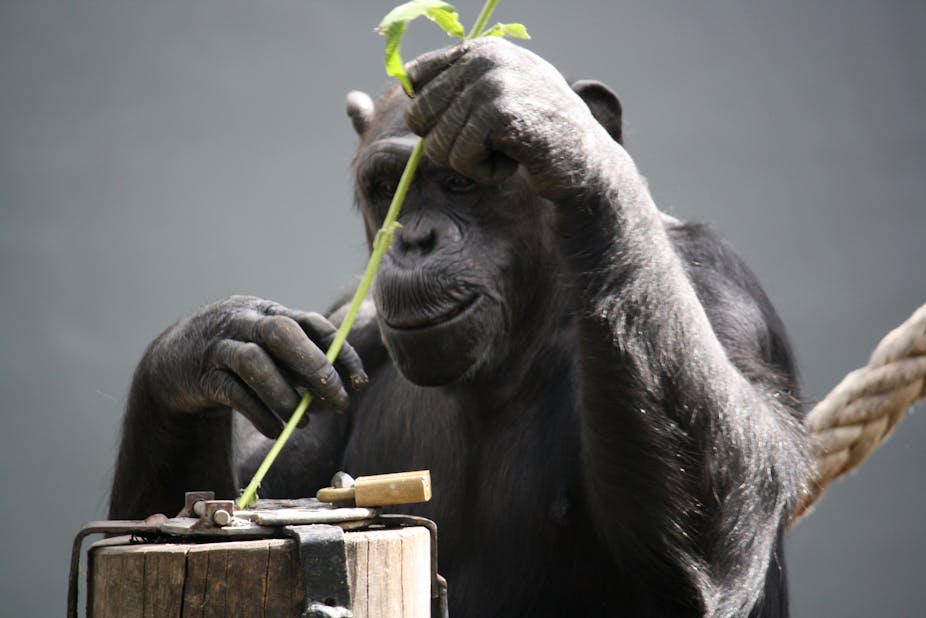A study published in PNAS this week has confirmed that human blood types were present in one of our ancient primate ancestors.
The ABO blood groups
Beloved by genetics teachers the world over, the ABO blood group is possibly the most well-known example of a genetic polymorphism - that is, when a single gene has two or more variants which produce different outcomes.
The gene that specifies our blood group produces an enzyme called glycosyltransferase which adds sugar molecules to the surface of red blood cells (RBCs).
There are three common variants of this enzyme: variants A and B add slightly different sugar molecules, while variant O is not functional.
The ABO system is important because it determines which type of sugar, if any, is attached to our RBCs. These sugars act as cell surface markers recognised by antibodies circulating in our blood.
To avoid being attacked by our own immune system, each of us only has antibodies that recognise the cell markers we are lacking. So if someone is blood group A, they will only have the antibodies that recognise the B cell marker.
If they receive blood by transfusion from someone who was type B, their antibodies will attack the donor RBCs, with serious health consequences.
Strikingly, the ABO blood types are present not only in humans, but in many other primate species too and the identical protein sequence changes are responsible for the A and B variants in each case. There were two possible reasons for this:
The AB blood types were already present in a common ancestor of all current primates and has been passed on unchanged for generations.
This is a case of convergent evolution, where the same variants have arisen by mutation independently in several different evolutionary lineages.
Until now, the consensus was that the A variant of the gene is the original, ancestral variant and the B variant evolved independently at least six times in primates.
New evidence
With their new paper, the PNAS researchers – led by Laure Ségurel from the University of Chicago – have challenged this consensus, providing compelling evidence that ABO blood types are ancient and predate the evolution of the various primate species alive today.
Ségurel and colleagues studied the sequence of the glycosyltransferase gene in 40 different primate species from the hominoids (humans, gorillas, chimpanzees and orangutans), old world and new world monkeys.
They closely examined two small sections of the gene flanking the AB gene site for additional sequence variation that might shed light on the evolutionary history of this gene.
These local gene sequences, were assembled into evolutionary trees (like biological family trees), which provide a graphical representation of the relatedness of gene sequences (see the original paper).
The result was startling: an A gene from one species (e.g. humans) was more closely related to the A gene from other species (e.g. gibbons) than to the B variant from the same species.
These results support a scenario in which the A and B blood types first arose in a distant common ancestor and have persisted across species.
But this did not rule out the possibility that other functionally important mutations, not just the A and B variants, had arisen in this small gene region independently in numerous species.
To distinguish between these hypotheses, the authors conducted an analysis of the DNA changes that would result in a possible change in enzyme activity, within and between the A and B blood types.
They concluded that the AB polymorphism is an early divergence of one ancestral gene into two functional variants, both of which have been maintained in various lineages to the current day, confirming the results mentioned above.
Ancient bloodlines
Ségurel and colleagues estimated the divergence of the ancestral gene to have occurred at least 20 million years ago. As such, this is only the second known example of human variation that can be traced back to the origin of hominoids.
For the AB blood types to have lasted so long some selection pressure must have been present to maintain them in such diverse species. As yet, we still don’t know exactly what that selective pressure could be.
Apart from the effect the ABO gene has during blood transfusions in humans (i.e. creating an immune response to foreign blood types), the function of this gene is not known.
In other primate species the gene is active in a wider variety of tissues and organs and may be important for the ability of pathogens to initiate infection. If this is the case, variants A and B may confer vulnerability to different pathogens.
Regardless of why this polymorphism has endured so well, this work provides a fascinating insight into our evolution and that of our closest relatives.

